MGT600: Peer Review of Presentation on Strategic People Management
VerifiedAdded on 2022/09/15
|6
|1670
|15
Report
AI Summary
This report is a peer review of a student's presentation on strategic management, focusing on the case of Westpac. The reviewer commends the presentation's clarity in articulating Westpac's vision, ethical practices, and approach to cultural and gender diversity. The review highlights the i...
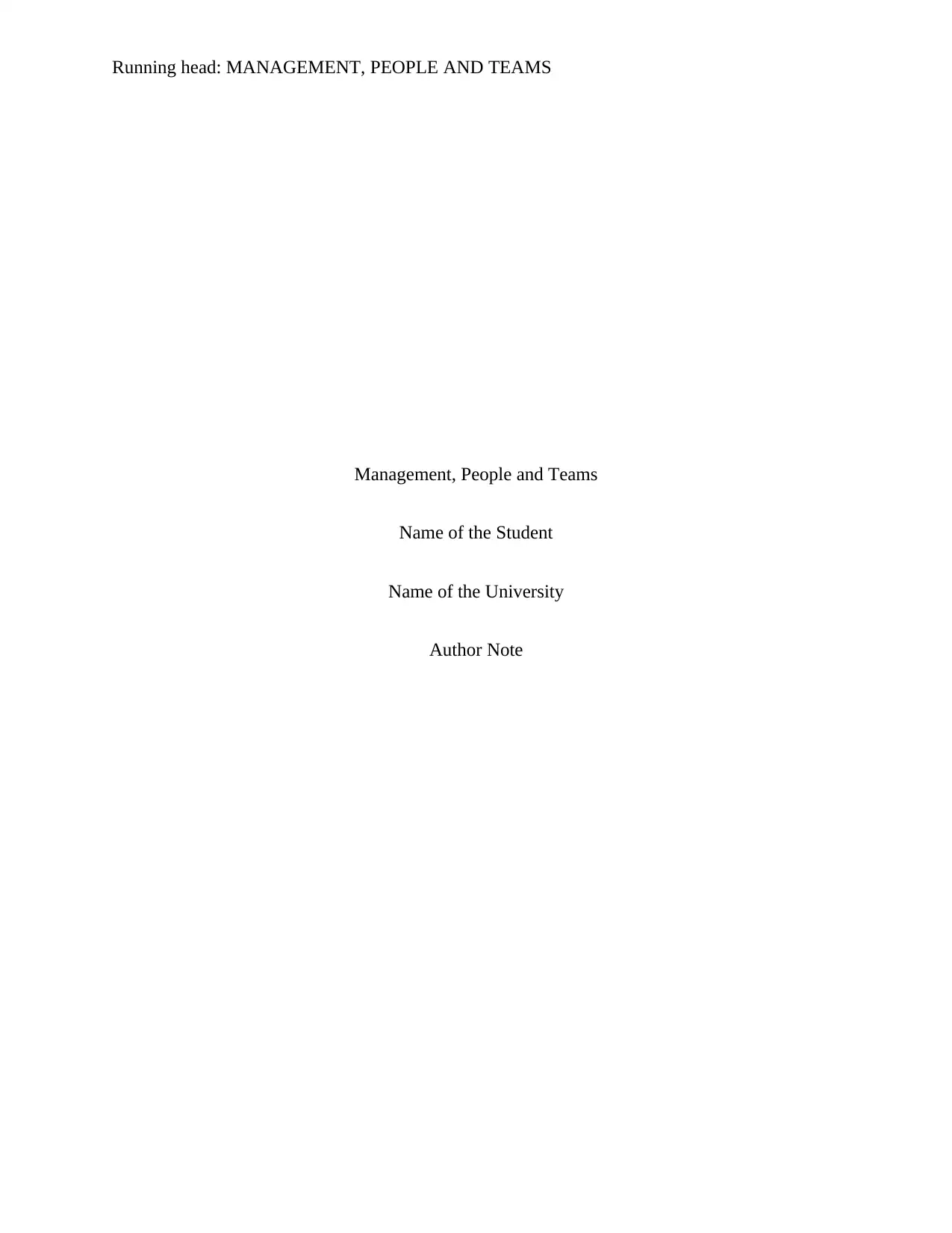
Running head: MANAGEMENT, PEOPLE AND TEAMS
Management, People and Teams
Name of the Student
Name of the University
Author Note
Management, People and Teams
Name of the Student
Name of the University
Author Note
Secure Best Marks with AI Grader
Need help grading? Try our AI Grader for instant feedback on your assignments.
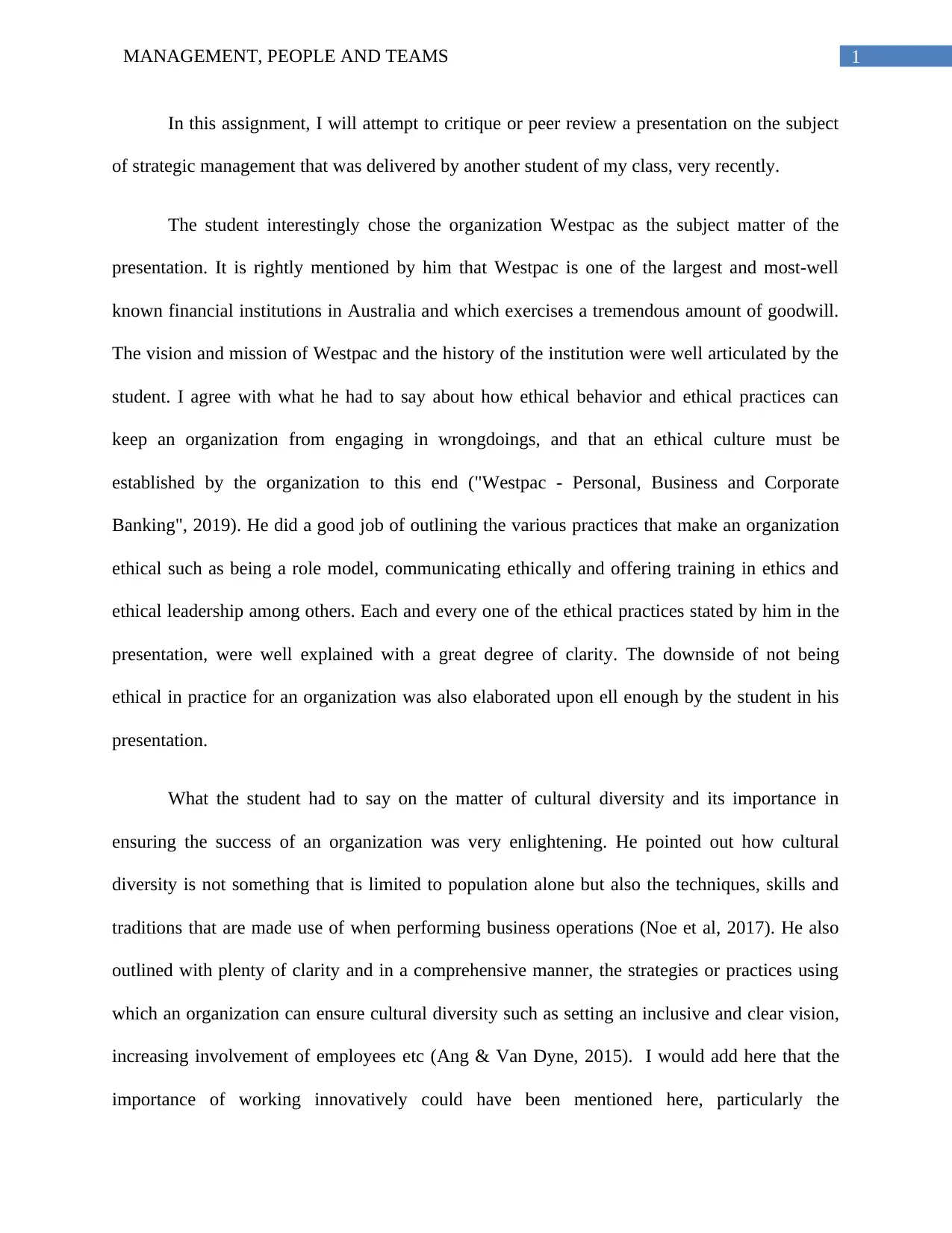
1MANAGEMENT, PEOPLE AND TEAMS
In this assignment, I will attempt to critique or peer review a presentation on the subject
of strategic management that was delivered by another student of my class, very recently.
The student interestingly chose the organization Westpac as the subject matter of the
presentation. It is rightly mentioned by him that Westpac is one of the largest and most-well
known financial institutions in Australia and which exercises a tremendous amount of goodwill.
The vision and mission of Westpac and the history of the institution were well articulated by the
student. I agree with what he had to say about how ethical behavior and ethical practices can
keep an organization from engaging in wrongdoings, and that an ethical culture must be
established by the organization to this end ("Westpac - Personal, Business and Corporate
Banking", 2019). He did a good job of outlining the various practices that make an organization
ethical such as being a role model, communicating ethically and offering training in ethics and
ethical leadership among others. Each and every one of the ethical practices stated by him in the
presentation, were well explained with a great degree of clarity. The downside of not being
ethical in practice for an organization was also elaborated upon ell enough by the student in his
presentation.
What the student had to say on the matter of cultural diversity and its importance in
ensuring the success of an organization was very enlightening. He pointed out how cultural
diversity is not something that is limited to population alone but also the techniques, skills and
traditions that are made use of when performing business operations (Noe et al, 2017). He also
outlined with plenty of clarity and in a comprehensive manner, the strategies or practices using
which an organization can ensure cultural diversity such as setting an inclusive and clear vision,
increasing involvement of employees etc (Ang & Van Dyne, 2015). I would add here that the
importance of working innovatively could have been mentioned here, particularly the
In this assignment, I will attempt to critique or peer review a presentation on the subject
of strategic management that was delivered by another student of my class, very recently.
The student interestingly chose the organization Westpac as the subject matter of the
presentation. It is rightly mentioned by him that Westpac is one of the largest and most-well
known financial institutions in Australia and which exercises a tremendous amount of goodwill.
The vision and mission of Westpac and the history of the institution were well articulated by the
student. I agree with what he had to say about how ethical behavior and ethical practices can
keep an organization from engaging in wrongdoings, and that an ethical culture must be
established by the organization to this end ("Westpac - Personal, Business and Corporate
Banking", 2019). He did a good job of outlining the various practices that make an organization
ethical such as being a role model, communicating ethically and offering training in ethics and
ethical leadership among others. Each and every one of the ethical practices stated by him in the
presentation, were well explained with a great degree of clarity. The downside of not being
ethical in practice for an organization was also elaborated upon ell enough by the student in his
presentation.
What the student had to say on the matter of cultural diversity and its importance in
ensuring the success of an organization was very enlightening. He pointed out how cultural
diversity is not something that is limited to population alone but also the techniques, skills and
traditions that are made use of when performing business operations (Noe et al, 2017). He also
outlined with plenty of clarity and in a comprehensive manner, the strategies or practices using
which an organization can ensure cultural diversity such as setting an inclusive and clear vision,
increasing involvement of employees etc (Ang & Van Dyne, 2015). I would add here that the
importance of working innovatively could have been mentioned here, particularly the
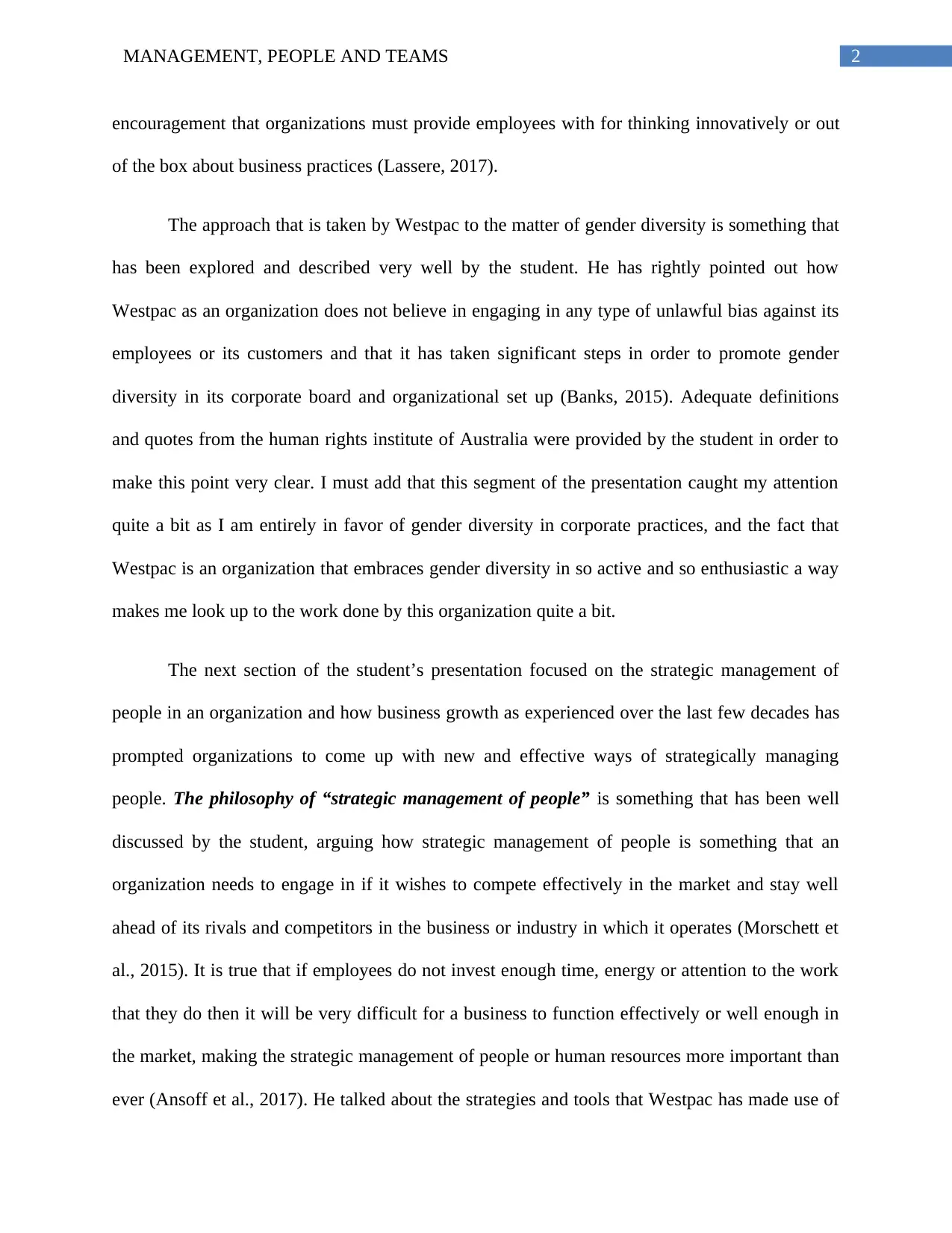
2MANAGEMENT, PEOPLE AND TEAMS
encouragement that organizations must provide employees with for thinking innovatively or out
of the box about business practices (Lassere, 2017).
The approach that is taken by Westpac to the matter of gender diversity is something that
has been explored and described very well by the student. He has rightly pointed out how
Westpac as an organization does not believe in engaging in any type of unlawful bias against its
employees or its customers and that it has taken significant steps in order to promote gender
diversity in its corporate board and organizational set up (Banks, 2015). Adequate definitions
and quotes from the human rights institute of Australia were provided by the student in order to
make this point very clear. I must add that this segment of the presentation caught my attention
quite a bit as I am entirely in favor of gender diversity in corporate practices, and the fact that
Westpac is an organization that embraces gender diversity in so active and so enthusiastic a way
makes me look up to the work done by this organization quite a bit.
The next section of the student’s presentation focused on the strategic management of
people in an organization and how business growth as experienced over the last few decades has
prompted organizations to come up with new and effective ways of strategically managing
people. The philosophy of “strategic management of people” is something that has been well
discussed by the student, arguing how strategic management of people is something that an
organization needs to engage in if it wishes to compete effectively in the market and stay well
ahead of its rivals and competitors in the business or industry in which it operates (Morschett et
al., 2015). It is true that if employees do not invest enough time, energy or attention to the work
that they do then it will be very difficult for a business to function effectively or well enough in
the market, making the strategic management of people or human resources more important than
ever (Ansoff et al., 2017). He talked about the strategies and tools that Westpac has made use of
encouragement that organizations must provide employees with for thinking innovatively or out
of the box about business practices (Lassere, 2017).
The approach that is taken by Westpac to the matter of gender diversity is something that
has been explored and described very well by the student. He has rightly pointed out how
Westpac as an organization does not believe in engaging in any type of unlawful bias against its
employees or its customers and that it has taken significant steps in order to promote gender
diversity in its corporate board and organizational set up (Banks, 2015). Adequate definitions
and quotes from the human rights institute of Australia were provided by the student in order to
make this point very clear. I must add that this segment of the presentation caught my attention
quite a bit as I am entirely in favor of gender diversity in corporate practices, and the fact that
Westpac is an organization that embraces gender diversity in so active and so enthusiastic a way
makes me look up to the work done by this organization quite a bit.
The next section of the student’s presentation focused on the strategic management of
people in an organization and how business growth as experienced over the last few decades has
prompted organizations to come up with new and effective ways of strategically managing
people. The philosophy of “strategic management of people” is something that has been well
discussed by the student, arguing how strategic management of people is something that an
organization needs to engage in if it wishes to compete effectively in the market and stay well
ahead of its rivals and competitors in the business or industry in which it operates (Morschett et
al., 2015). It is true that if employees do not invest enough time, energy or attention to the work
that they do then it will be very difficult for a business to function effectively or well enough in
the market, making the strategic management of people or human resources more important than
ever (Ansoff et al., 2017). He talked about the strategies and tools that Westpac has made use of
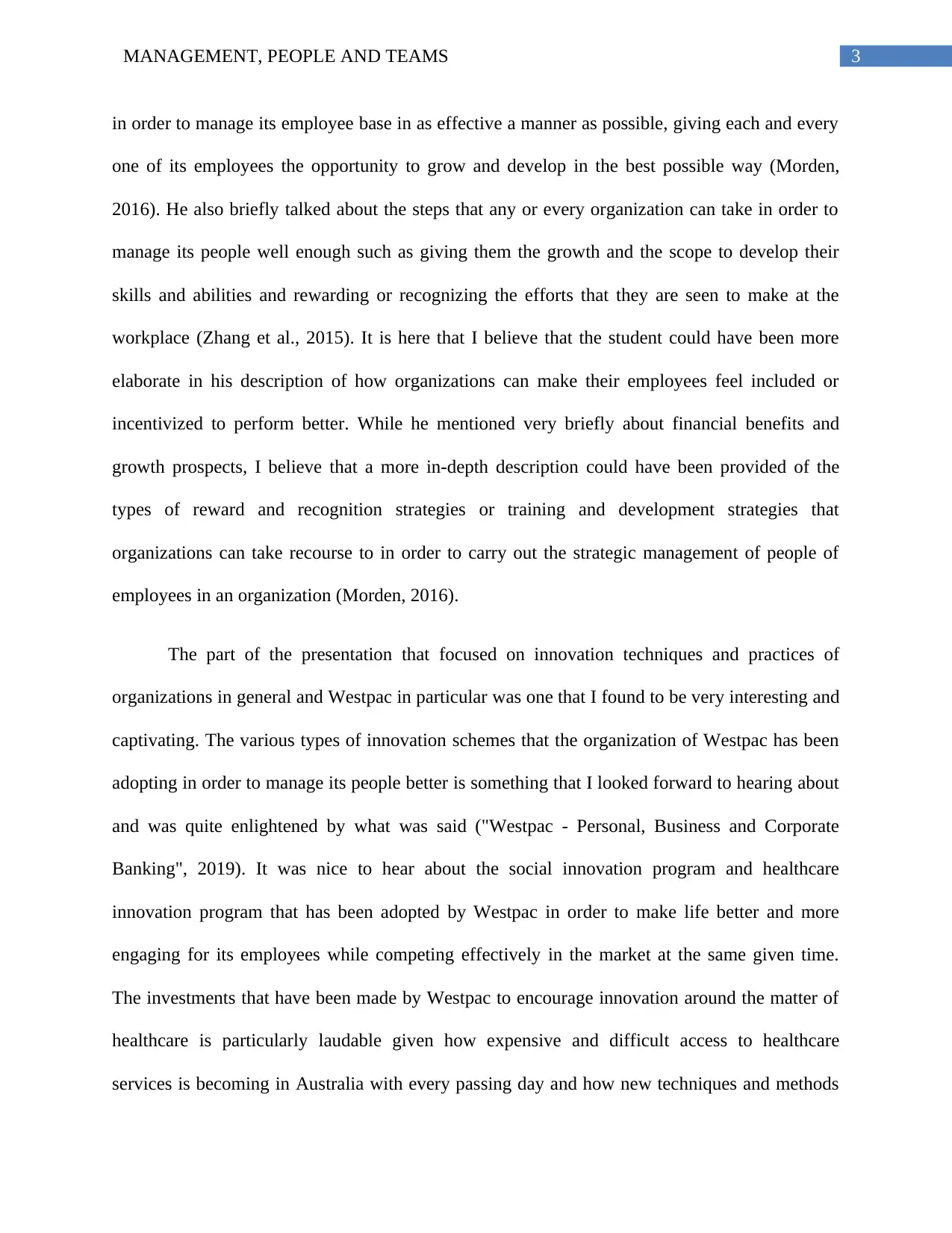
3MANAGEMENT, PEOPLE AND TEAMS
in order to manage its employee base in as effective a manner as possible, giving each and every
one of its employees the opportunity to grow and develop in the best possible way (Morden,
2016). He also briefly talked about the steps that any or every organization can take in order to
manage its people well enough such as giving them the growth and the scope to develop their
skills and abilities and rewarding or recognizing the efforts that they are seen to make at the
workplace (Zhang et al., 2015). It is here that I believe that the student could have been more
elaborate in his description of how organizations can make their employees feel included or
incentivized to perform better. While he mentioned very briefly about financial benefits and
growth prospects, I believe that a more in-depth description could have been provided of the
types of reward and recognition strategies or training and development strategies that
organizations can take recourse to in order to carry out the strategic management of people of
employees in an organization (Morden, 2016).
The part of the presentation that focused on innovation techniques and practices of
organizations in general and Westpac in particular was one that I found to be very interesting and
captivating. The various types of innovation schemes that the organization of Westpac has been
adopting in order to manage its people better is something that I looked forward to hearing about
and was quite enlightened by what was said ("Westpac - Personal, Business and Corporate
Banking", 2019). It was nice to hear about the social innovation program and healthcare
innovation program that has been adopted by Westpac in order to make life better and more
engaging for its employees while competing effectively in the market at the same given time.
The investments that have been made by Westpac to encourage innovation around the matter of
healthcare is particularly laudable given how expensive and difficult access to healthcare
services is becoming in Australia with every passing day and how new techniques and methods
in order to manage its employee base in as effective a manner as possible, giving each and every
one of its employees the opportunity to grow and develop in the best possible way (Morden,
2016). He also briefly talked about the steps that any or every organization can take in order to
manage its people well enough such as giving them the growth and the scope to develop their
skills and abilities and rewarding or recognizing the efforts that they are seen to make at the
workplace (Zhang et al., 2015). It is here that I believe that the student could have been more
elaborate in his description of how organizations can make their employees feel included or
incentivized to perform better. While he mentioned very briefly about financial benefits and
growth prospects, I believe that a more in-depth description could have been provided of the
types of reward and recognition strategies or training and development strategies that
organizations can take recourse to in order to carry out the strategic management of people of
employees in an organization (Morden, 2016).
The part of the presentation that focused on innovation techniques and practices of
organizations in general and Westpac in particular was one that I found to be very interesting and
captivating. The various types of innovation schemes that the organization of Westpac has been
adopting in order to manage its people better is something that I looked forward to hearing about
and was quite enlightened by what was said ("Westpac - Personal, Business and Corporate
Banking", 2019). It was nice to hear about the social innovation program and healthcare
innovation program that has been adopted by Westpac in order to make life better and more
engaging for its employees while competing effectively in the market at the same given time.
The investments that have been made by Westpac to encourage innovation around the matter of
healthcare is particularly laudable given how expensive and difficult access to healthcare
services is becoming in Australia with every passing day and how new techniques and methods
Secure Best Marks with AI Grader
Need help grading? Try our AI Grader for instant feedback on your assignments.
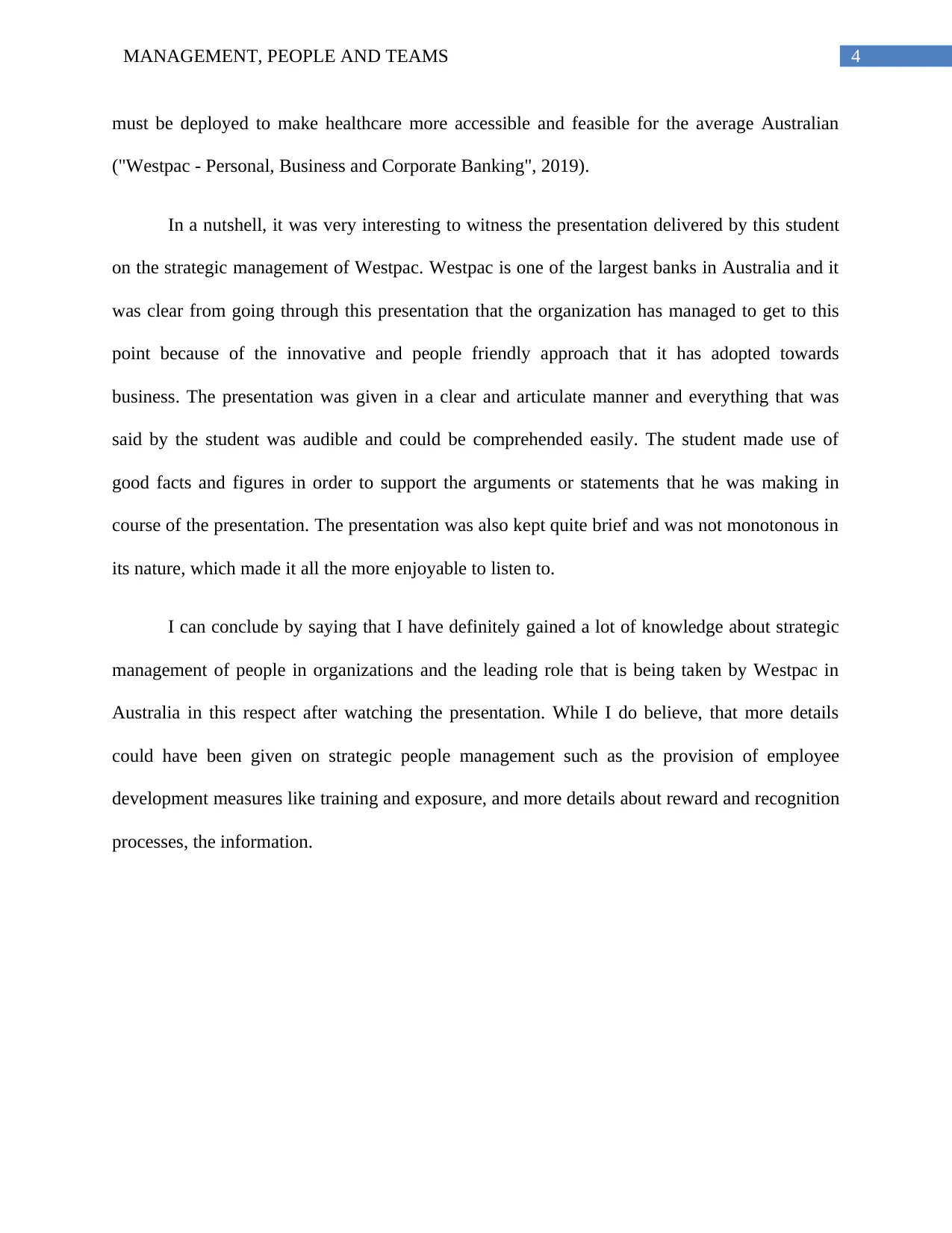
4MANAGEMENT, PEOPLE AND TEAMS
must be deployed to make healthcare more accessible and feasible for the average Australian
("Westpac - Personal, Business and Corporate Banking", 2019).
In a nutshell, it was very interesting to witness the presentation delivered by this student
on the strategic management of Westpac. Westpac is one of the largest banks in Australia and it
was clear from going through this presentation that the organization has managed to get to this
point because of the innovative and people friendly approach that it has adopted towards
business. The presentation was given in a clear and articulate manner and everything that was
said by the student was audible and could be comprehended easily. The student made use of
good facts and figures in order to support the arguments or statements that he was making in
course of the presentation. The presentation was also kept quite brief and was not monotonous in
its nature, which made it all the more enjoyable to listen to.
I can conclude by saying that I have definitely gained a lot of knowledge about strategic
management of people in organizations and the leading role that is being taken by Westpac in
Australia in this respect after watching the presentation. While I do believe, that more details
could have been given on strategic people management such as the provision of employee
development measures like training and exposure, and more details about reward and recognition
processes, the information.
must be deployed to make healthcare more accessible and feasible for the average Australian
("Westpac - Personal, Business and Corporate Banking", 2019).
In a nutshell, it was very interesting to witness the presentation delivered by this student
on the strategic management of Westpac. Westpac is one of the largest banks in Australia and it
was clear from going through this presentation that the organization has managed to get to this
point because of the innovative and people friendly approach that it has adopted towards
business. The presentation was given in a clear and articulate manner and everything that was
said by the student was audible and could be comprehended easily. The student made use of
good facts and figures in order to support the arguments or statements that he was making in
course of the presentation. The presentation was also kept quite brief and was not monotonous in
its nature, which made it all the more enjoyable to listen to.
I can conclude by saying that I have definitely gained a lot of knowledge about strategic
management of people in organizations and the leading role that is being taken by Westpac in
Australia in this respect after watching the presentation. While I do believe, that more details
could have been given on strategic people management such as the provision of employee
development measures like training and exposure, and more details about reward and recognition
processes, the information.
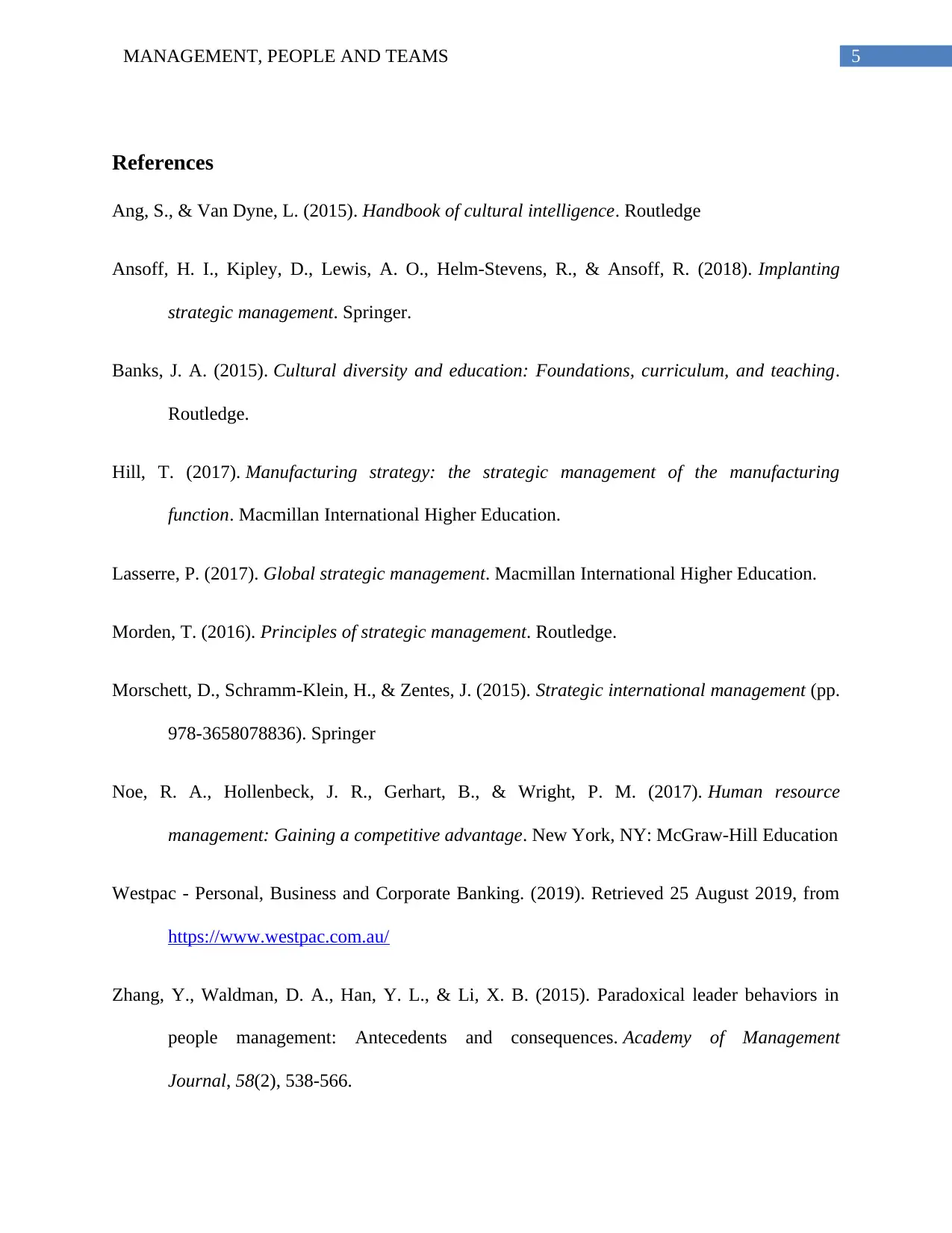
5MANAGEMENT, PEOPLE AND TEAMS
References
Ang, S., & Van Dyne, L. (2015). Handbook of cultural intelligence. Routledge
Ansoff, H. I., Kipley, D., Lewis, A. O., Helm-Stevens, R., & Ansoff, R. (2018). Implanting
strategic management. Springer.
Banks, J. A. (2015). Cultural diversity and education: Foundations, curriculum, and teaching.
Routledge.
Hill, T. (2017). Manufacturing strategy: the strategic management of the manufacturing
function. Macmillan International Higher Education.
Lasserre, P. (2017). Global strategic management. Macmillan International Higher Education.
Morden, T. (2016). Principles of strategic management. Routledge.
Morschett, D., Schramm-Klein, H., & Zentes, J. (2015). Strategic international management (pp.
978-3658078836). Springer
Noe, R. A., Hollenbeck, J. R., Gerhart, B., & Wright, P. M. (2017). Human resource
management: Gaining a competitive advantage. New York, NY: McGraw-Hill Education
Westpac - Personal, Business and Corporate Banking. (2019). Retrieved 25 August 2019, from
https://www.westpac.com.au/
Zhang, Y., Waldman, D. A., Han, Y. L., & Li, X. B. (2015). Paradoxical leader behaviors in
people management: Antecedents and consequences. Academy of Management
Journal, 58(2), 538-566.
References
Ang, S., & Van Dyne, L. (2015). Handbook of cultural intelligence. Routledge
Ansoff, H. I., Kipley, D., Lewis, A. O., Helm-Stevens, R., & Ansoff, R. (2018). Implanting
strategic management. Springer.
Banks, J. A. (2015). Cultural diversity and education: Foundations, curriculum, and teaching.
Routledge.
Hill, T. (2017). Manufacturing strategy: the strategic management of the manufacturing
function. Macmillan International Higher Education.
Lasserre, P. (2017). Global strategic management. Macmillan International Higher Education.
Morden, T. (2016). Principles of strategic management. Routledge.
Morschett, D., Schramm-Klein, H., & Zentes, J. (2015). Strategic international management (pp.
978-3658078836). Springer
Noe, R. A., Hollenbeck, J. R., Gerhart, B., & Wright, P. M. (2017). Human resource
management: Gaining a competitive advantage. New York, NY: McGraw-Hill Education
Westpac - Personal, Business and Corporate Banking. (2019). Retrieved 25 August 2019, from
https://www.westpac.com.au/
Zhang, Y., Waldman, D. A., Han, Y. L., & Li, X. B. (2015). Paradoxical leader behaviors in
people management: Antecedents and consequences. Academy of Management
Journal, 58(2), 538-566.
1 out of 6
Related Documents
Your All-in-One AI-Powered Toolkit for Academic Success.
+13062052269
info@desklib.com
Available 24*7 on WhatsApp / Email
![[object Object]](/_next/static/media/star-bottom.7253800d.svg)
Unlock your academic potential
© 2024 | Zucol Services PVT LTD | All rights reserved.





